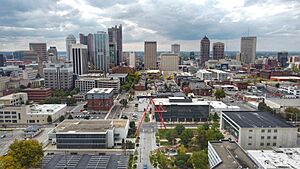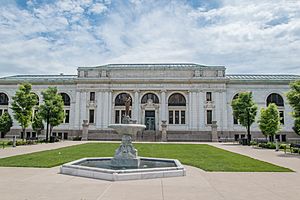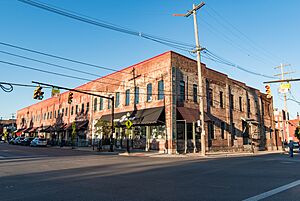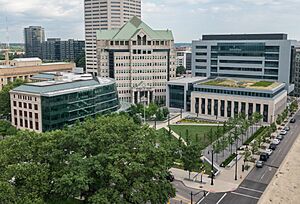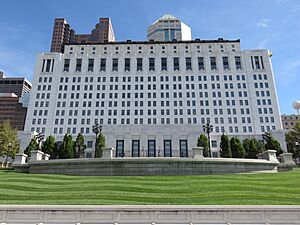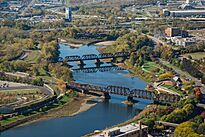Downtown Columbus, Ohio facts for kids
Quick facts for kids
Downtown Columbus
|
|
|---|---|
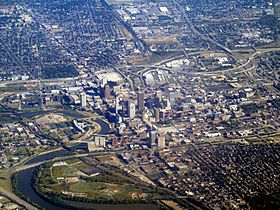
Downtown Columbus from the southwest in 2015
|
|
| Country | United States |
| State | Ohio |
| County | Franklin |
| City | Columbus |
| Population
(2019)
|
|
| • Total | 9,270 |
Downtown Columbus is the main business area of Columbus, Ohio. It is located around the intersection of Broad and High Streets. This area includes everything inside the Inner Belt. Downtown Columbus is home to many of the city's tallest buildings.
The Ohio Statehouse, which is the state capitol building, stands in the center of downtown. Downtown also has several colleges like Columbus State Community College and Franklin University. You can also find the Main Library and the unique Main Street Bridge here.
Downtown Columbus has many different neighborhoods. The main areas are the Discovery District, the High Street Corridor, and the Riverfront. Other important parts include the Arena District and Capitol Square. Many people work and study downtown. As of 2022, about 11,200 people live there.
Contents
- Discovering Downtown Columbus
- A Look Back: Downtown's History
- Exploring Downtown's Geography
- The Arena District: Sports and Fun
- Discovery District: Learning and Art
- River South District: Parks and River Views
- Uptown District: Government and Entertainment
- Market-Mohawk District: A Changing Neighborhood
- Park Street District: Food and Fun
- Fort Hayes: A Historic Military Site
- Civic Center: City Government Hub
- Downtown's Population
- Important Buildings and Landmarks
- Downtown's Economy
- Entertainment in Downtown
- Getting Around Downtown
Discovering Downtown Columbus
A Look Back: Downtown's History
The city of Columbus started in 1812 to be Ohio's new capital. The first settlement was west of the Scioto River. But plans quickly expanded east to what is now downtown Columbus. By 1814, important buildings like a prison and the first school were built.
Columbus became an official town in 1816. In 1824, it became the county seat. John Brooks was elected its first mayor in 1834. The city has grown outwards from the original 10-acre plot around the Statehouse. This makes downtown the true center of Columbus.
The Scioto River is also a key part of downtown. It flows right through the area. Downtown Columbus has changed over time. It went from a government center to an industrial and business hub. Today, it is the main commercial center of central Ohio. The first modern skyscraper, LeVeque Tower, was built in 1927. Many other tall buildings have been added since then.
Bringing Life Back: Urban Renewal
In the 1950s, many cities started projects to improve older, rundown areas. They received money from the government to clear these areas. This was done to make the city better for everyone. In 1952, Columbus began its own urban renewal efforts. These projects helped improve areas like Market Mohawk and German Village.
Exploring Downtown's Geography
Columbus was chosen for its central location in Ohio. It is also where the Scioto River and Olentangy River meet. The heart of downtown Columbus is at Broad Street and High Street. Downtown is generally the area within the Scioto River, Interstate 70, Interstate 71, and Interstate 670. The last of these highways, I-670, was finished in 2003.
Downtown Columbus is surrounded by other neighborhoods. To the north is The Short North. To the west is Franklinton. To the south are German Village and the Brewery District. To the east are Olde Towne East and King-Lincoln Bronzeville.
The Arena District: Sports and Fun
The Arena District is in the northwest part of downtown. It is home to exciting places like Nationwide Arena and Huntington Park. Nationwide Arena is where the Columbus Blue Jackets hockey team plays. It also hosts concerts and other events. The arena opened in 2000.
Huntington Park is home to the Columbus Clippers baseball team. They are a minor league team for the Cleveland Guardians. This park opened in 2009. The LC Pavilion is also here. It is a unique venue that hosts indoor and outdoor concerts. The Arena District also has many restaurants and cafes. This area used to have old factories. It started to be redeveloped in 1996.
Discovery District: Learning and Art
The Discovery District is on the eastern side of downtown. It is a hub for culture, art, and education. The Columbus Metropolitan Library's Main Library is located here. So is the Columbus Museum of Art.
You can also find several schools in this district. Columbus State Community College offers two-year degrees. It has almost 25,000 students. The Columbus College of Art and Design was founded in 1879. It teaches about 1,300 students. The Capital University Law School is also in this district. A special group works to improve safety and the look of this neighborhood.
River South District: Parks and River Views
The River South District is in the southwest part of downtown. It runs along the Scioto River. A major attraction here is Columbus Commons, a 7-acre green space. It was built in 2010 where the City Center Mall used to be. It has an outdoor stage called Bicentennial Pavilion.
Another highlight is the Scioto Mile. This is a network of parks and trails along the Scioto River. It connects different parts of downtown. You can visit Bicentennial Park and the River South Art Walk here.
Uptown District: Government and Entertainment
The Uptown District, also called the High Street Corridor, follows High Street. The Ohio Statehouse is located in this district. It is the state's capitol building.
The Uptown District also has historic theaters. These include the Ohio Theatre and the Palace Theatre. The LeVeque Tower, Columbus's first skyscraper, is also in this district. It stands near the Scioto River.
Market-Mohawk District: A Changing Neighborhood
The Market-Mohawk District is in the southeast part of downtown. It used to be a residential area. As Columbus grew, it became a mix of homes and businesses. In the 1950s and 1960s, this area was part of a big urban renewal project.
New buildings were constructed, including facilities for Greyhound Lines and Franklin University. These buildings were designed in a modern style. Today, Franklin University is still here. You can also find the Ohio Democratic Party Building and the Ohio Republican Party Building. The Market-Mohawk Center, built in 1970, is a historic building in this district.
Park Street District: Food and Fun
The Park Street District is in the northernmost part of downtown. It includes the North Market Historic District. This area used to be a center for factories and wholesale businesses. In 1980, it was redeveloped into a lively area with restaurants and entertainment.
The North Market is a popular spot here. It is the only original market left from the four that Columbus once had. Many restaurants, bars, offices, and shops are found along Park Street.
Fort Hayes: A Historic Military Site
The Fort Hayes area is northeast of downtown. It was originally built as a United States barracks (military housing). By 1875, it became a training facility. It was first called the Columbus Barracks. In 1922, it was renamed Fort Hayes after Governor and President Rutherford B. Hayes.
By 1976, the military left Fort Hayes. The Columbus Public Schools bought 50 acres of the land for just $1. They created the Fort Hayes Metropolitan Education Center. In 1988, the Fort Hayes Arts and Academic High School was started. Notable buildings still there include Shot Tower and the Education Center.
Civic Center: City Government Hub
The Civic Center is the central area for the city government. It is home to many city buildings. As Columbus grew, the city needed more office space. This area covers about 5.75 acres in western downtown. Important buildings here include Columbus City Hall and the headquarters of the Columbus Division of Police.
Downtown's Population
In 2019, about 18,660 people lived in the 43215 zip code. This area includes downtown and East Franklinton. This number was 46% higher than in 2010.
Important Buildings and Landmarks
The Ohio Statehouse: State Capitol
The Ohio Statehouse was built between 1839 and 1861. It was designed in the Greek-Revival style. Much of the building uses Columbus Limestone from the Scioto River banks. The Statehouse is a National Historic Landmark.
Ohio Judicial Center: State Supreme Court
The Thomas J. Moyer Ohio Judicial Center was built in 1933. It has housed different government departments over the years. Since 2004, it has been the home of the Ohio Supreme Court. The building has murals, plaques, and statues that show Ohio's history.
Scioto Mile: Riverfront Parks
The Scioto Mile is a collection of parks along the Scioto River. These nine parks connect parts of the Scioto Greenway Trail with downtown.
Genoa Park is a 2.07-acre park on Broad Street. It has an amphitheater for events and concerts. It also offers access to the Greenway Trail. The park is near COSI, a science entertainment center. Genoa Park opened in 1999 and has the Columbus Police Memorial.
The McFerson Commons is a 2.21-acre park in the Arena District. It was built after the Ohio State Penitentiary was torn down. The park is named after a former CEO of Nationwide Insurance. Its main feature is an arch from the old Columbus Union Station.
Historic Districts: Preserving the Past
Downtown Columbus has many historic districts. Some are listed on the National Register of Historic Places. These include the High and Gay Streets Historic District and the North Market Historic District. These areas help preserve the history and unique character of downtown.
Downtown's Economy
Many large businesses and organizations are based in downtown Columbus. Companies like Nationwide, AEP, and Huntington have buildings here. The Columbus Dispatch, the city's main newspaper, is also headquartered downtown. There are also many venues that attract visitors, such as Nationwide Arena and the Greater Columbus Convention Center.
Entertainment in Downtown

Downtown Columbus offers many entertainment choices. You can find bars, restaurants, sporting events, and concerts. Besides Nationwide Arena and the LC Pavilion, downtown has historic theaters. These include the Southern Theatre and the Ohio Theatre. Many restaurants and bars are located along High Street and in the surrounding areas.
Getting Around Downtown
Transportation
The main public transportation is the Central Ohio Transit Authority (COTA) bus system. Greyhound Lines also has a bus station downtown. You can also use taxicabs or ridesharing services like Lyft and Uber. Several interstates, such as I-70, I-71, and I-670, run through downtown. There are also bike lanes on many streets.
Food Access
Downtown Columbus does not have a large commercial grocery store. This means it can be hard for some residents to get fresh food. The Hills Market is an independent grocery store that sells local and organic foods. It is the only grocery store in downtown Columbus.


